Washington State Accessible IT Capacity Building Institute on Policy #188 (2016)
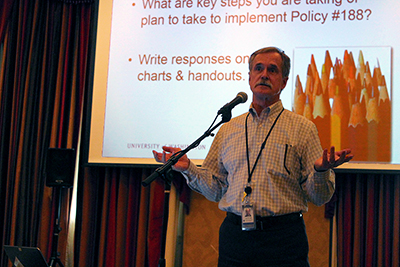
This publication shares the proceedings of Washington State Accessible IT Capacity Building Institute on Policy #188, which was held in Seattle, Washington on November 29 – 30, 2016. Attendees included individuals identified by their institution as the Policy #188 IT accessibility coordinator from higher education institutions across Washington State. Policy #188 serves to ensure that IT procured, developed, and used by state agencies, including public colleges and universities, is accessible to and usable by individuals with disabilities.
These proceedings may be useful for people who
- participated in the CBI,
- have been identified to be the coordinator regarding the agency’s information technology accessibility plan and to support complaint resolution,
- are developing policy and processes to support and ensure compliance with this policy and associated standard, and
- are addressing similar accessible IT issues at postsecondary institutions nationwide.
This event was sponsored by UW Accessible Technology Services (ATS) at the University of Washington (UW), a UW-IT (University of Washington Information Technology) unit that directs both the Access Technology and DO-IT (Disabilities, Opportunities, Internetworking, and Technology) Centers. The meeting was facilitated by Dr. Sheryl Burgstahler, the director of ATS. ATS’s two centers are dedicated to empowering people with disabilities through technology and education. They promote awareness and accessibility to maximize the potential of individuals with disabilities and make our communities more vibrant, diverse, and inclusive.
The DO-IT Center strives to
- increase the success of people with disabilities in challenging academic programs and careers;
- promote the application of universal design to physical spaces, information technology, instruction, and services;
- freely distribute online content, publications, and videos for use in presentations, exhibits, and the classroom; and
- provide resources for students with disabilities, K-12 educators, postsecondary faculty and administrators, librarians, employers, parents, and mentors.
The Access Technology Center (ATC) focuses on ensuring UW students, faculty, and staff with disabilities have the same access to technology—including computers, software, and special equipment—as other students, faculty, and staff. ATC staff help individuals select and use assistive technology and supports a showroom with numerous products:
- speech and braille output
- screen magnification
- alternatives to the keyboard and mouse
- speech recognition software
- tools to make reading and writing easier and computer use more comfortable
- the capacity to create documents in e-text and braille
The show room includes a collection of accessible science equipment such as automatic stirrers, tactile measuring devices, and talking calculators. The ATC provides braille embossing and tactile graphics for the UW community.
ATC staff promote the development and use of accessible technology products by
- encouraging student computing facilities to include assistive technology;
- offering courses, delivering presentations, and conducting ATC tours for UW classes and other groups;
- working with campus units to prepare documents, videos, and other materials in accessible electronic formats;
- assisting campus web developers in designing accessible websites and applications;
- working with vendors of IT products used by the UW to improve accessibility; and
- supporting a central resource to provide guidance to technologists and administrators at the UW and beyond.
About the CBI
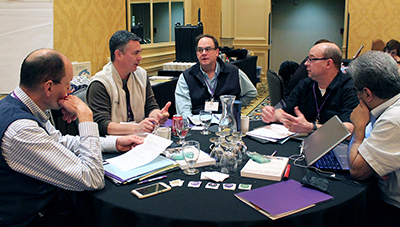
The Washington State Accessible IT Capacity Building Institute on Policy #188 provided a forum for prioritizing work to help every institution meet the two deadlines presented in the Policy.
By December 31, 2016, agencies must identify an information technology accessibility coordinator to be the key contact regarding the agency’s information technology accessibility plan and to support complaint resolution, and develop policy and processes to support and ensure compliance with this policy and associated standard.
By March 31, 2017 the initial agency plan must be developed and posted.
The CBI included presentations and discussions. In small working groups, participants responded to the following questions:
- What are questions/concerns you have about implementing Policy #188 on your campus?
- What are key steps you are taking or plan to take to implement Policy #188?
- What are the campus leaders/units that should be involved in complying with Policy #188, what roles do/will they play, & what processes are in place or need to be developed?
In this CBI
- all participants contributed to its success,
- experts in key topic areas were in the audience, and
- new ideas evolved from discussions.
CBI participants shared their diverse perspectives and expertise. The agenda for the CBI and summaries of the presentations are provided on the following pages.
Agenda
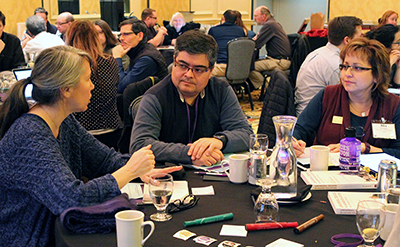
Tuesday, November 29
8:00 – 9:00 am
Breakfast and Networking
9:00 – 9:30
Welcome, Introductions
Meeting Goal: Improve the accessibility of IT developed, procured, & used by public postsecondary institutions in Washington State
Objectives:
- Increase understanding of requirements of Policy #188
- Share & develop plans for implementing Policy
- Build relationships between those implementing Policy state-wide
9:30 – 10:30
Overview of Legal Foundation for Accessible IT
Definition of “Accessible”
Lessons Learned from Resolutions of Legal Challenges Regarding the Accessibility of IT at Other Schools
Meeting Facilitator: Sheryl Burgstahler, Policy #188 Coordinator, University of Washington
10:45 – 12
Overview of State Policy #188 Requirements
Sheryl Burgstahler, Q&A about Policy #188: Engagement with Ryan Leisinger, WATech
12:00 – 12:45
Lunch & Discussion: What are questions/concerns you have about implementing Policy #188 on your campus?
Write responses on post-its & place on poster sheets
1:00 – 1:30
Welcome from Aaron Powell, UW’s Interim Vice President for UW-IT & CIO
1:30 – 2:15
Small Group Discussions: What are key steps you are taking or plan to take to implement Policy #188?
Write responses on flip charts & handouts
2:30 – 3:00
Report out From Small Group Discussions
3:00 – 4:00
Small Group Discussions: What are the campus leaders/units that should be involved in complying with Policy #188, what roles do/will they play, & what processes are in place or need to be developed?
Write responses on flip charts & handouts
4:00 – 5:00
Report out From Small Group Discussions, Further Discussion, & Plans for Tomorrow
Wednesday, November 30
8:00 – 9:00 am
Breakfast & Networking
9:00 – 9:45
Feedback from Yesterday & Discussion of How Campuses Can Collaborate in Meeting Policy #188 Requirements
9:45 – 10:30
Develop Individual Campus Plans in Groups or as Individuals
10:45 – 12
Report-out From Campus Plan Development Activity
Resources available, resources desired, and ways to continue to work together
12:00 –
Lunch & Continued Discussion
Presentation Summaries
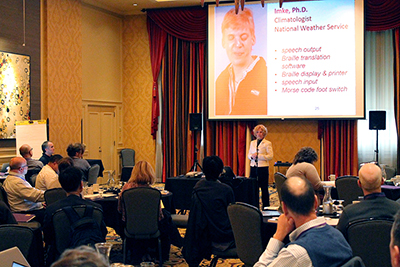
Overview of Legal Foundation for Accessible IT
Presenter: Sheryl Burgstahler, University of Washington, with input from attendees
Educational institutions across the nation are under scrutiny for failing to offer accessible classes and online resources. Many civil rights complaints have been made because IT is not accessible to individuals with disabilities—including uncaptioned videos, unreadable PDFs, and inaccessible websites and information kiosks. The legal basis for these lawsuits is Section 504 of the Rehabilitation Act of 1973, the Americans with Disabilities Act (ADA) of 1990 and it’s 2008 amendments, and other state and local laws. Policy #188 is meant to help us comply with these laws and collaborate in our efforts to ensure that our IT is accessible to all faculty, students, staff, and visitors.
According to the U.S. Department of Justice and the Office of Civil Rights of the U.S. Department of Education, “accessible” means a person with a disability is afforded the opportunity to acquire the same information, engage in the same interactions, and enjoy the same services as a person without a disability in an equally effective and equally integrated manner. On our campuses, everyone’s ability to see, hear, learn, walk, etc. falls somewhere on a continuum. Regardless of where that is, we want to ensure that they have access to the IT we procure, develop and use.
There are two approaches for making our campuses accessible: accommodations and universal design. Accommodations are reactive and allow us to fix a product or environment to be accessible to an individual who finds it inaccessible (e.g., captioning a video when a student with a hearing impairment requests it). Universal design is the proactive design of creating all aspects as accessible as possible before offering services and resources to others. A building that is technically accessible would have a separate ramp for people with wheelchairs, while a building that is universally designed would have one entrance that is accessible for all.
To make IT accessible, software and websites have to be designed with disabilities and assistive technology in mind. Some assistive technology emulates a keyboard but not a mouse, tabs from link to link, reads from heading to heading, and has issues with image and audio content. This means all information technology needs to be created with keyboard-only functionality, alternative text, descriptive links, structured hierarchical headings, video captions, and transcribed audio.
From other lawsuits and accessibility cases, we have learned the importance of gaining support from key leaders, building on existing roles and processes, developing partnerships with vendors, applying top down and bottom up approaches, sharing consistent messages on accessibility, securing a leadership commitment, leveraging third parties for consultation and audits, adopting a reporting process, engaging with community members with disabilities, and ensuring wide publication of accessibility issues and solutions.
The University of Washington (UW) utilizes these resolutions, the 2015 EDUCAUSE IT Accessibility Risk Statements and Evidence report, and Policy #188 to guide its steps towards improved IT accessibility. UW promotes accessibility within an inclusive campus culture. Other tasks IT departments can take on include the following:
- Create a partnership with Disability Resource Services.
- Develop the ideal state and gap analyses.
- Conduct an audit of the accessibility of IT to develop a corrective action strategy.
- Set and disseminate institutional standards related to accessible technology.
- Create, produce, and monitor compliance to ensure IT developed, procured, or used by the institution is accessible.
- Provide training and resources about accessibility to those responsible for creating or procuring IT and creating content.
- Institute procedures for addressing accessibility as a requirement.
- Provide and publicize a mechanism by which students, faculty, staff, and members of the public can report access barriers.
- Work in a committee to find and fix accessibility issues.
Learn more about what the UW is doing, see other institution’s civil rights complaints resolutions, and find more resources at the UW Accessibility page.
Overview of State Policy #188 Requirements
Presenter: Sheryl Burgstahler, University of Washington
WA Policy #188 establishes the expectation for state agencies that people with disabilities have access to and use of information and data and be provided access to the same services and content that is available to people without disabilities. By December 31, 2016, agencies must identify an IT accessibility coordinator as the key contact regarding the agency’s information technology accessibility plan, as well as the first line of support for complaint resolution. Agencies must also develop policies and processes to ensure compliance with Policy #188; although agencies might currently have goals and accessibility statements, these plans should be refreshed and tailored to ensure Policy #188 compliance. By March 31, a compliance plan should be put in place to describe how an institution will ensure new IT is accessible and how existing IT will be made accessible. The plan will contain a list of prioritized non-accessible IT, recommended alternatives for access to these technologies, and actions to be taken to make these technologies accessible.
For each instance of noncompliance of a technology, a waiver must be requested by the state CIO with a corrective action plan for each area of noncompliance and identification of the barriers and compromised functionality in relation to this noncompliance.
Q&A about Policy #188: Engagement with Ryan Leisinger, WATech
Attendees were invited to ask questions about Policy #188. Below is a summary of the responses.
What does the policy mean by “not possible due to technical or legal limitations”?
The “technical” aspect specifically looks at some systems set in place by the state government, where there are older interfaces that cannot be made fully accessible. The “legal” aspect was added so that accessibility couldn’t be used as a loophole to access protected data.
Why is there such a stringent deadline?
That date will encourage us to plan together instead of procrastinating. These requirements are meant to showcase how each institution is moving forward with accessibility.
Is research included in Policy #188?
Research is not included in the scope of the policy, but it is recommended that accessibility issues be addressed since both the ADA and Section 504 cover research applications.
If something is excluded due to “not possible due to technical or legal limitations,” does a waiver still have to be filled out? How do I know what specific IT to fill out a waiver for?
We hope to change the culture to include accessibility in Washington State. It doesn’t necessarily matter how many people are going to use a system or product, except possibly for prioritization. All IT should eventually be made as accessible as possible. The Office of the Chief Information Officer (OCIO) will not be auditing to determine if all waivers are submitted.
Is the waiver form available now?
Yes, on the Office of the CIO website.
Will everything have to have a waiver?
I would prefer that waivers be used to test products for accessibility and to find out what isn’t accessible. If you know a vendor is working on something, put that in a waiver. The waiver should include a plan for improving accessibility. The waiver is not a punishment, but rather an opportunity to discuss these accessibility options.
How will we get vendors to create more accessible products, especially if a specific vendor is the only one who makes a specific technology?
We are writing a statement to be used when communicating with vendors about accessibility. If something cannot be made accessible right away, look at making accommodations for the current product, then ask the vendor to provide a more accessible product by a specific deadline.
All software purchasers should be included in the policy for buying accessible software. If a purchaser doesn’t realize the ramifications for inaccessibility, or even how to tell if something is inaccessible, they won’t change their approach.
Is there a shared resource for finding accessible vendors and software?
There are some lists out there, but there is certainly room for a bigger database or shared resource including the accessibility information of all software products.
Where do we start and what should we prioritize?
From a legal standpoint, we should start with technology for which there have been accessibility complaints. Next we should focus on human resources software and software accessed by the public. The initial plan should cover all current high priority products, but also be a working document that can be expanded. You should also look for low-hanging fruit. It’s easier to train or contract for others to create accessible websites, PDFs, and videos, so that may be a good place to start as well.
Are hardware and equipment rentals included in Policy #188?
Policy #188 only looks at software. However, the ADA covers hardware and other IT and campus accessibility.
What are the repercussions for not following Policy #188?
The outcome is that your school won’t meet a state standard, which could have repercussions.
What is an example of an accessible software that could be used to showcase accessibility?
It’s rare that an application fully complies with Web Content Accessibility Guidelines (WCAG) 2.0 guidelines. Accessibility is not a switch that can just be turned on and off. Accessibility is a spectrum, with software lying somewhere on that spectrum.
Policy #188 seems to be a risk management tool—if I bring this forward to some faculty, how do I prevent them from just scrapping entire projects to remove the risk? How do we go about talking to the administration about this policy?
Policy #188 will change the culture with respect to IT accessibility. Companies put out new updates and software on a regular basis. They are constantly taking feedback about technology and making changes in new updates. This is a good model to follow, with accessibility in a constant conversation between the user and the producer. We want to constantly be making products more usable. There will always be conflicts between accessibility, availability, and quick turn around.
And remember—it isn’t just you in this room taking this on. There are allies across your institution. There are allies across the nation. And we can all collaborate, find resources, and work together to make all of our tools, equipment, and spaces as accessible as possible.
Discussion Summaries
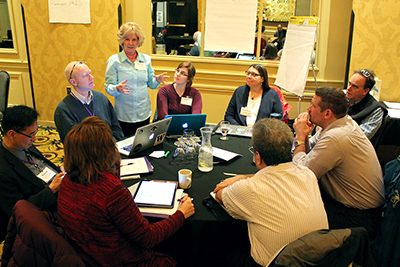
The following are examples of responses given to discussion questions.
What are questions/concerns you have about implementing Policy #188 on your campus?
Some questions and concerns were discussed during the CBI and submitted on handouts. Some are listed below.
What tools and infrastructure can we use to collaborate?
- We created “The Matrix,” a list of all of our supporting systems and shared contracts. This is a great thing to look back on for accessibility testing. This might be something we could share with other colleges and universities.
- At our school, we created a spreadsheet to track high priority software, whether it had a Voluntary Product Accessibility Template (VPAT), and whether the vendor promoted accessibility. We could use student employees to help collect more information and evaluate functional accessibility. We will store this information in a database.
- VPATs can often be written by people who don’t actually understand functional accessibility.
- The state security audit could be a good place to get information about products used on campus.
- WATech has an existing usability lab and a designated staff doing full usability testing. There hasn’t been a discussion about who should have access to this testing information, but I think the information belongs to each agency, not the state.
Are there any existing rubrics to evaluate software?
- The OCR resolutions shared some resources.
- The Accessible Technology Services team has created a checklist for following the WCAG and meeting these accessibility needs. It is posted online at www.uw.edu/accessibility/checklist.
- There are a few automated tools, listed on the UW Accessible IT website. But don’t rely on these too strongly—these tools can only address about 30% of accessibility issues; they do not look at functional accessibility at all. Site Improve is an example of this. It also finds spelling errors, dead links, and accessibility issues and is mainly a tool to just improve your website overall.
- Pa11y (http://pa11y.org/) runs code against validation and user reports. Tenon (https://tenon.io/) can also validate the code. There are a lot of programs that test to make sure the code employs accessible design practices.
- Open source software can be evaluated just like any other; moreso, if you have the skills, you have access to the code and can fix it yourself, then you can send it back to the provider.
How does academic freedom play into accessibility?
- Faculty will always have to accommodate, and they should understand that.
- I’ve had a faculty member argue that they had the freedom to use whatever software they wanted. Does someone in the institution have the power to tell that faculty they need to find an accessible option?
How do we promote a culture shift from individual (accommodation) to inclusivity (universal design)?
- Changing culture is always a long process. One way to promote change is to infiltrate meetings on various topics to infuse accessibility into the conversation. Diversity discussions should include issues related to accessibility. Technology discussions should include accessibility issues.
- Join online communities and bring accessibility up whenever possible.
Additional Questions Submitted
- What are the envisioned roles and responsibilities of the accessibility coordinator?
- Where will we find funding? Can we apply for grants related to accessibility?
- How do we define “high risk” technology, and how do we pick what we prioritize?
- What granularity is expected for IT (e.g., plug ins for WordPress)?
- Will this policy and the systems handled be spearheaded by the colleges or the state?
- Is there support for a state level database of products with information regarding accessibility?
- How will we make sure everyone complies with the policy?
- Will audits be scheduled to ensure compliance, similar to the Office of Civil Rights?
- How does Policy #188 affect private institutions?
- What is the best way to collaborate across campuses to share resources?
- Should we create a knowledge base to be shared to discuss commonly used software and other technology?
- How do we get faculty interested in accessibility?
- How do we best share what faculty need to know, including adjunct and short-term faculty?
- How much training will be included and how much time will it take to bring staff and faculty up to full compliance?
- Are teaching tools and related third party products (Purusall, etc.) covered in Policy #188?
- Are we including accessibility in curriculum for students in education, IT, computer science, etc?
- What do we do about CTCLink and who will ensure its accessibility and compliance?
- What are some tools for checking accessibility for websites and software?
- Are there any existing rubrics or assessment tools available to assess existing technology?
- How can we work together to test accessibility of software?
- How can we break this down into more manageable pieces?
- How do we promote a culture shift to include accessibility?
- How can we address accessibility issues for students with cognitive disabilities?
- Has accessibility and disability be included in diversity efforts?
- Will the office of the CIO publically post waivers online?
- Will civil rights groups look at our waivers and use them to file class action lawsuits against us?
- How can we use waivers to pressure vendors into providing more accessible products?
- How can we foster innovation in a classroom with new technologies while accommodating and incorporating accessibility?
- How will we get others on campus to continue participating and being involved in accessibility tasks?
What are key steps you are taking or plan to take to implement Policy #188?
- Create a series of deadlines to get certain things made accessible or certain steps taken.
- Add accessibility to the web and publication style guide.
- Add accessibility to different events and materials to promote a culture shift.
- Formally identify teams—including faculty, disability resource services, procurement, students, and IT—define roles (including a key leader), and share resources.
- Include influencers and motivated people instead of just assigning the role to people who are less interested.
- Create new accessibility resources to share across campus.
- Create an online forum for faculty to engage in discussion about technology and software.
- Focus on the user experience and bring to the table materials that showcase the user experience to engage those who are unsure of why things need to be made accessible.
- Make sure all IT purchases go through an accessibility review to review the VPAT and other accessibility promises.
- Host workshops for faculty to learn how to make accessible PDFs and caption videos.
- Showcase 3PlayMedia, which is a captioning service contracted by the state for all Washington higher education institutions (http://www.3playmedia.com/).
- Look at OCR cases and consider those resolutions as we create our own policy.
- Find or create a list of all software used on campus to determine what needs to be evaluated and where the priorities are.
- Update university and departmental style guides to include the accessibility guidelines.
- Update our technology request form to include accessibility.
- Work collectively with other colleges so we don’t have to reinvent the wheel.
- Create a process that ensures faculty and staff follow through on compliance with accessibility.
- Provide evaluations to faculty and staff for their software and hardware resources.
- Document all processes, including testing, criteria, training, standardization, and awareness promotion.
- Post the policy online and promote it to the institution.
- Target funding sources (groups that will benefit the most from accessibility) for particularly important tasks.
- Present accessibility awareness to different departments.
What are the campus leaders/units that should be involved in complying with Policy #188, what roles do/will they play, and what processes are in place or need to be developed?
- The bookstore proactively engages with textbook sellers and would be the one to discuss accessibility with them.
- An advisory group or task force that finds out what needs to be done on campus.
- Curriculum committee, bringing accessibility into the conversation and adding guidelines that faculty have to follow before getting curriculum approved.
- Marketing, since they are the first contact for most students and should be inviting by having accessible materials.
- A new person hired who can respond to both the IT side and the faculty side and bridge the gap for accessibility.
- Tenure committee, to make sure accessibility is on faculty radar.
- People who are really interested and the stakeholders should be engaged, since they will help promote the issue—this could be in the form of an open call for engagement as well as direct invitation.
- An executive buy-in from the president or provost, as well as school deans, to promote this idea from above.
- IT staff should have at least one skilled person testing all software for accessibility.
- Board of trustees and cabinet should be invited to promote financial investment.
- E-learning coordinators need to be on board to make sure all online classes are accessible.
- Libraries need to be involved to make sure all additional learning environments will also be kept in the loop and can promote accessibility in libraries.
- Web masters across campus should be invited to discuss accessibility and create a plan for full web accessibility by a specific date.
- The medical center and athletics department should also be reviewed for used software and accessibility.
- Survey sent to current students and alumni about accessibility and software used.
Develop Individual Campus Plans in Groups or as Individuals
- Our student services unit is the only place to mention Section 504. I want to change this by bringing disability and accessibility into the conversation across campus. We will look at who we can get on board to help manage and run the tasks required and start making products more accessible.
- Our first plan is to look at the accessibility of the learning management system we use. Then we will start evaluating all software and websites students and faculty use, prioritized by level of use.
- Our first priority is to look at our new enterprise resource planning software that will be rolling out. I haven’t heard any mention of accessibilitywith respect to this software, and it will be a huge target for complaints if we don’t make sure it is accessible.
- I want to promote a cultural change around accessibility and drive faculty to be more inclusive. Faculty have been resistant and overwhelmed to this change, since often it can seem insurmountable. We want instead to tackle it in small pieces by offering faculty smaller options to start with.
- Processes need to be developed for librarians, educational outreach programs, faculty, and student programs for making sure all software they use is accessible. Each group should have their own plan that work in tandem with others.
- Connections will be created for collaborating both across campus and across institutions to find partnerships and share the load.
- We plan on working with other institutions to each adopt a specific product or software and work with the vendor to make it more accessible.
- We are hoping to add an Accessible Media Center to our Accessible Technology Center, where websites, documents, and captioning can be made more proactively. Faculty and students could come in and get help on these topics.
- By hiring a trained, trusted tester, we can evaluate all of our products by the same set of standards.
CBI Participants
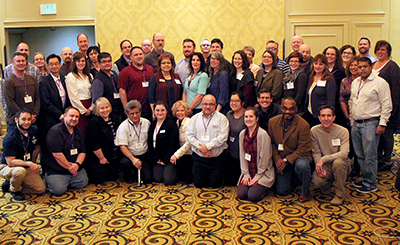
Stakeholder groups represented in the CBI included
- student service leaders and administrators,
- faculty members,
- students, and
- professional organizations.
The following individuals participated in the CBI.
Abbay, Lynne
Olympic College
Ales, Maria
Seattle Central College
Bronsema, Max
Western Washington University
Brown, Kayla
University of Washington
Burgstahler, Sheryl
University of Washington
Campbell, Ian
University of Washington
Chambers, Kathleen
North Seattle College
Chan, Brian
Green River College
Comden, Dan
University of Washington
Corey, Dana
Pierce College
Corigliano, Paul
Renton Technical College
Crawford, Lyla
University of Washington
Fraser, Scott
Washington State University
Gerard, Carly
Gonzaga University
Gilbertson, Torey
University of Washington
Golden, Anna Marie
University of Washington
Greear, Krista
University of WA
Hansen, Joyce
Seattle College District
Hartman, Robert
Bellingham Technical College
Hayman, Doug
University of Washington
Heiser, Andy
Skagit Valley College
Hodgen, Ken
Walla Walla Community College
Hsu, Raymond
University of Washington
Irish, Bridget
The Evergreen State College
Krauss, Clay
Tacoma Community College
Larreau, Tim
Washington State University Tri-Cities
Lattin, Zach
Clark College
Leisinger, Ryan
WATech
Madison, Rose
Everett Community College
Miche, Yanko
Eastern Washington University
Naf, Ward
Whatcom Community College
Park, Karen J.
Seattle Pacific University
Peoples, Vanessa
Community Colleges of Spokane
Pow, Patrick
University of Washington Tacoma
Powell, Aaron
University of Washington
Rangin, Hadi
University of Washington
Rasul, Kamran
Columbia Basin College
Rohr, Katy
Centralia College
Rover, Amy
Shoreline Community College
Seda, Jeremy P.
Big Bend Community College
Smith, Eva
Edmonds Community College
Steele, Wendy
Washington State University Global Campus (Online Education)
Taylor, Michael
Clover Park Technical College
Taylor, Patrick
Bates Technical College
Thompson, Ana
University of Washington Bothell
Thompson, Jess
WA State Board for Community & Technical Colleges
Thompson, Terrill
University of Washington
Tucker, Jeannie
Wenatchee Valley College
Wegner, Mary Kay
Bellevue College
Wenke, Richard
Grays Harbor College
Winkelbauer, Nick
University of Washington
Communities of Practice
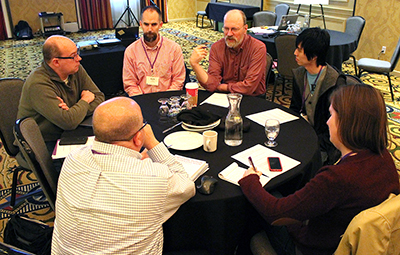
UW Accessible Technology Services engages stakeholders within Communities of Practice (CoPs). CoP members share perspectives and expertise and identify practices that promote the participation of people with disabilities in postsecondary education.
Accessible IT CoP
This CoP is populated with disability services and IT professionals interested in increasing the accessibility of IT in postsecondary education, particularly in Washington State. Participants
- exchange information, ideas, and suggestions for future collaboration,
- gain and share knowledge and help identify issues related to IT accessibility in higher education, and
- recruit others to participate in the CoP.
Universal Design in Higher Education CoP
This CoP is comprised of individuals interested in exploring universal design (UD) and its applications in higher education. Participants on this CoP discuss
- promising practices for infusing universal design on postsecondary campuses;
- applying UD to all educational opportunities that include instruction, technology, student services and physical spaces; and
- specific topics in the book Universal Design and Higher Education: From Principles to Practice and contribute materials to be shared through the Center on Universal Design in Education.
Accessible Distance Learning CoP
Distance learning program administrators, instructors, and support staff use the Accessible Distance Learning CoP to increase their knowledge about disabilities and make changes in distance learning that lead to more inclusive practices. Members discuss
- management,
- staffing,
- training, and
- policy issues related to creating accessible distance learning courses and programs.
You and your colleagues can join the CoP by sending the following information to doit@uw.edu:
- name
- position/title
- institution
- postal address
- email address
- name of the CoP
Visit online for more information about other CoPs.
Resources
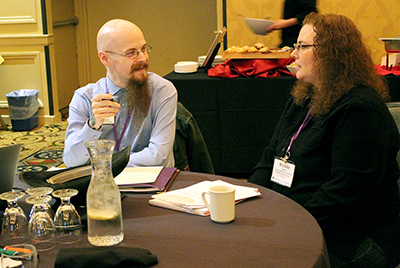
You can find the full text for Policy #188, information about waivers, and the minimum accessibility standard by visiting these websites:
- Policy #188
- Standard #188.10 – Minimum Accessibility Standard
- Policy #103 – Technology Policy & Standards Waiver Request
The UW’s Accessible Technology website includes a variety of resources:
- the IT accessibility policy and guidelines for the UW
- legal issues and civil rights complaints and resolutions nationwide
- instructions and tips for making IT accessible
- more resources for creating and procuring accessible IT products
The DO-IT (Disabilities, Opportunities, Internetworking, and Technology) website contains the following:
- information about DO-IT projects
- evidence-based practices that support project goals and objectives
- resources for students with disabilities
- educational materials for teachers and administration
DO-IT maintains a searchable database of frequently asked questions, case studies, and promising practices related to how educators and employers can fully include students with disabilities. The Knowledge Base is an excellent resource for ideas that can be implemented in programs in order to better serve students with disabilities. In particular, the promising practices articles serve to spread the word about practices that show evidence of improving the participation of people with disabilities in postsecondary education.
Examples of Knowledge Base questions include the following:
- Are electronic whiteboards accessible to people with disabilities?
- Are peer review tools accessible?
- Are there computer keyboards designed to be used with only one hand?
- Are touch screens accessible?
- Do postsecondary institutions have to provide assistive technology (for example, screen enlargement or voice recognition software) to students with disabilities who enroll in distance learning courses?
- Does a postsecondary institution have to provide specific hardware or software (known as assistive technology) that an individual with a disability requests so that they can access information technology used on campus?
- Does making our school web content accessible mean I cannot use multimedia on my site?
- How can educational entities determine if their websites are accessible?
Individuals and organizations are encouraged to propose questions and answers, case studies, and promising practices for the Knowledge Base. Contributions and suggestions can be sent to doit@uw.edu.
For more information on making your campus technology accessible and to learn more about accessible learning or universal design, review the following websites and brochures:
- WCAG 2.0 are the expected guidelines to be followed for all websites
- The Access Technology Center’s website
- A list of thirty different web accessibility tips, and how to implement those tips
- Accessibility training and certification
- More information about accessibility standards and procurement
- Cheat sheets for making accessible documents and content, as well as a plethora of other resources for accessible websites
- The AccessDL website shares resources for making distance learning and online courses accessible
- Accessible University’s website featuring common web accessibility principles and solutions
- A brochure on universally designing distance-learning programs
- A brochure on what accessible distance learning is and how it helps students
- A brochure on the top tips for creating an accessible distance-learning course
- A brochure on why accessible web design matters, and some resources to make your website accessible
- Blindmath is a listserv for those who want to learn more about all issues around accessible mathematics
- More information on universal design in education can be found at the Center for Universal Design in Education
Conferences can be a great way to share resources, collaborate, and come up with new ideas. Consider attending the following:
- ATHEN (Accessing Higher Ground)
- CSUN
- ATIA
- Closing the Gap
- Smaller, local IT conferences, like TechConnect
- NW E-Learn
- EDUCAUSE
- Building Bridges
- Faculty Accessibility Retreat for 2-year colleges
Acknowledgments
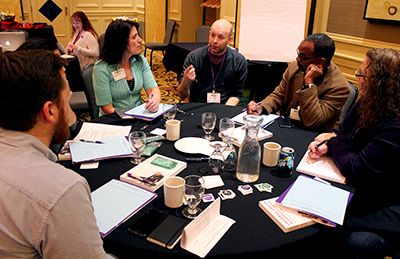
The Washington State Accessible IT Capacity Building Institute on Policy #188 was funded by Access Technology Services at the University of Washington. Any opinions, findings, and conclusions or recommendations expressed in this material are those of the CBI presenters, attendees, and publication authors and do not necessarily reflect the views of the University of Washington.
Accessible Technology Services
University of Washington
Box 354842
Seattle, WA 98195-4842
www.washington.edu/accessibility/
www.washington.edu/doit/
206-685-3648 (voice/TTY)
888-972-3648 (toll free voice/TTY)
206-221-4171 (FAX)
509-328-9331 (voice/TTY) Spokane
© 2016 University of Washington. Permission is granted to copy this publication for educational, noncommercial purposes, provided the source is acknowledged.